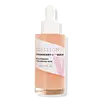What's inside
What's inside
 Key Ingredients
Key Ingredients

 Benefits
Benefits

 Concerns
Concerns

No concerns
 Ingredients Side-by-side
Ingredients Side-by-side

Water
Skin ConditioningPropanediol
SolventGlycerin
HumectantLeuconostoc/Radish Root Ferment Lysate Filtrate
Skin ConditioningPanthenol
Skin ConditioningFragaria Ananassa Seed Extract
AntioxidantFragaria Vesca Fruit Extract
AstringentTerminalia Ferdinandiana Fruit Extract
AntioxidantSodium Hyaluronate
HumectantSea Water
HumectantCucumis Sativus Fruit Extract
EmollientPicea Abies Extract
Skin Conditioning3-O-Ethyl Ascorbic Acid
Skin ConditioningCarbomer
Emulsion StabilisingAminomethyl Propanol
BufferingBentonite
AbsorbentSodium Citrate
BufferingSodium Phytate
Citric Acid
BufferingCI 77491
Cosmetic ColorantCI 77499
Cosmetic ColorantWater, Propanediol, Glycerin, Leuconostoc/Radish Root Ferment Lysate Filtrate, Panthenol, Fragaria Ananassa Seed Extract, Fragaria Vesca Fruit Extract, Terminalia Ferdinandiana Fruit Extract, Sodium Hyaluronate, Sea Water, Cucumis Sativus Fruit Extract, Picea Abies Extract, 3-O-Ethyl Ascorbic Acid, Carbomer, Aminomethyl Propanol, Bentonite, Sodium Citrate, Sodium Phytate, Citric Acid, CI 77491, CI 77499
Water
Skin ConditioningDimethicone
EmollientHydrogenated Vegetable Oil
EmollientStearic Acid
Cleansing1,2-Hexanediol
Skin ConditioningCetyl Ethylhexanoate
EmollientBakuchiol
AntimicrobialSodium Hyaluronate
HumectantCitrus Junos Seed Oil
EmollientCurcuma Longa Root Extract
MaskingBoerhavia Diffusa Root Extract
Skin ProtectingPinus Pinaster Bark Extract
AntioxidantLimnanthes Alba Seed Oil
Skin ConditioningBetaine
HumectantCopernicia Cerifera Wax
Carbomer
Emulsion StabilisingPropanediol
SolventCaprylic/Capric Triglyceride
MaskingGlycerin
HumectantXanthan Gum
EmulsifyingDextrin
AbsorbentTin Oxide
AbrasiveTocopherol
AntioxidantSorbitol
HumectantPhosphatidylcholine
EmulsifyingDocosahexaenoic Acid
Skin ConditioningEicosapentaenoic Acid
EmollientSynthetic Fluorphlogopite
Citrus Junos Peel Oil
AstringentSodium Phytate
Tetrasodium Glutamate Diacetate
Phytosphingosine
Skin ConditioningMonascus Extract
Skin ConditioningTocopheryl Acetate
AntioxidantTromethamine
BufferingTitanium Dioxide
Cosmetic ColorantEthylhexylglycerin
Skin ConditioningWater, Dimethicone, Hydrogenated Vegetable Oil, Stearic Acid, 1,2-Hexanediol, Cetyl Ethylhexanoate, Bakuchiol, Sodium Hyaluronate, Citrus Junos Seed Oil, Curcuma Longa Root Extract, Boerhavia Diffusa Root Extract, Pinus Pinaster Bark Extract, Limnanthes Alba Seed Oil, Betaine, Copernicia Cerifera Wax, Carbomer, Propanediol, Caprylic/Capric Triglyceride, Glycerin, Xanthan Gum, Dextrin, Tin Oxide, Tocopherol, Sorbitol, Phosphatidylcholine, Docosahexaenoic Acid, Eicosapentaenoic Acid, Synthetic Fluorphlogopite, Citrus Junos Peel Oil, Sodium Phytate, Tetrasodium Glutamate Diacetate, Phytosphingosine, Monascus Extract, Tocopheryl Acetate, Tromethamine, Titanium Dioxide, Ethylhexylglycerin
 Reviews
Reviews

Ingredients Explained
These ingredients are found in both products.
Ingredients higher up in an ingredient list are typically present in a larger amount.
Carbomer is a polymer of acrylic acid. Its main role is to create a gel consistency.
A high amount of carbomer can cause pilling or balling up of products. Don't worry, most products contain 1% or less of carbomer.
Glycerin is already naturally found in your skin. It helps moisturize and protect your skin.
A study from 2016 found glycerin to be more effective as a humectant than AHAs and hyaluronic acid.
As a humectant, it helps the skin stay hydrated by pulling moisture to your skin. The low molecular weight of glycerin allows it to pull moisture into the deeper layers of your skin.
Hydrated skin improves your skin barrier; Your skin barrier helps protect against irritants and bacteria.
Glycerin has also been found to have antimicrobial and antiviral properties. Due to these properties, glycerin is often used in wound and burn treatments.
In cosmetics, glycerin is usually derived from plants such as soybean or palm. However, it can also be sourced from animals, such as tallow or animal fat.
This ingredient is organic, colorless, odorless, and non-toxic.
Glycerin is the name for this ingredient in American English. British English uses Glycerol/Glycerine.
Learn more about GlycerinPropanediol is an all-star ingredient. It softens, hydrates, and smooths the skin.
It’s often used to:
Propanediol is not likely to cause sensitivity and considered safe to use. It is derived from corn or petroleum with a clear color and no scent.
Learn more about PropanediolSodium Hyaluronate is hyaluronic acid's salt form. It is commonly derived from the sodium salt of hyaluronic acid.
Like hyaluronic acid, it is great at holding water and acts as a humectant. This makes it a great skin hydrating ingredient.
Sodium Hyaluronate is naturally occurring in our bodies and is mostly found in eye fluid and joints.
These are some other common types of Hyaluronic Acid:
Learn more about Sodium HyaluronateSodium Phytate is the synthetic salt form of phytic acid. Phytic acid is an antioxidant and can be found in plant seeds.
Sodium Phytate is a chelating agent. Chelating agents help prevent metals from binding to water. This helps stabilize the ingredients and the product.
Water. It's the most common cosmetic ingredient of all. You'll usually see it at the top of ingredient lists, meaning that it makes up the largest part of the product.
So why is it so popular? Water most often acts as a solvent - this means that it helps dissolve other ingredients into the formulation.
You'll also recognize water as that liquid we all need to stay alive. If you see this, drink a glass of water. Stay hydrated!
Learn more about Water